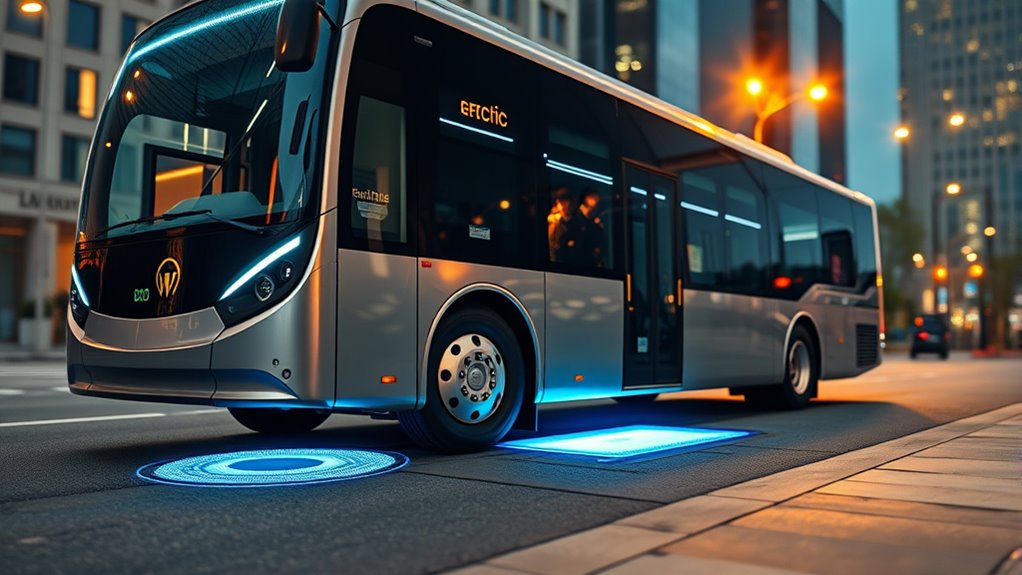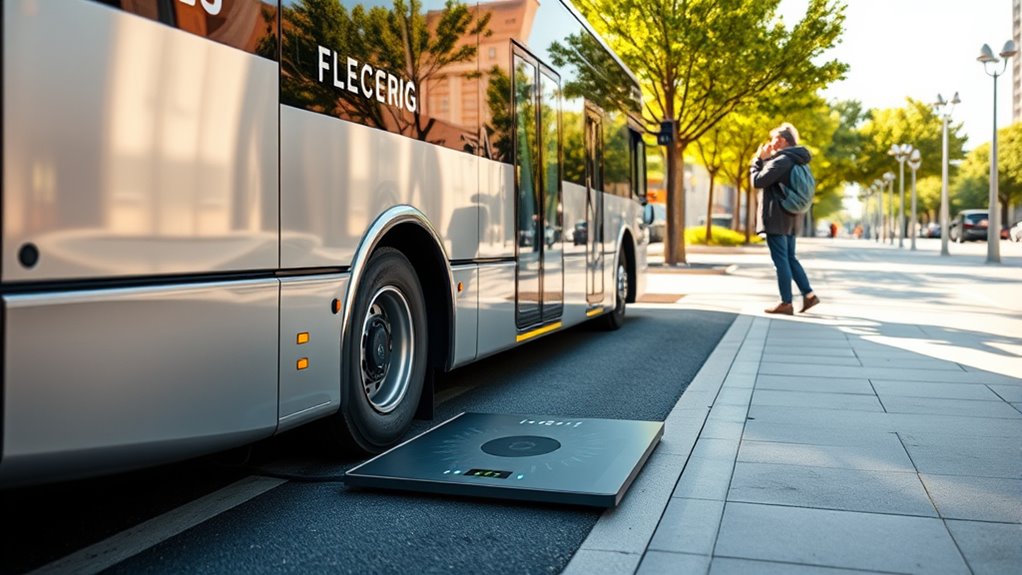Wireless charging for electric buses is highly feasible and increasingly practical. It uses proven electromagnetic resonant coupling technology, allowing seamless power transfer during stops or while in motion. This reduces the need for manual plugging, lowers labor costs, and can decrease battery sizes, making buses lighter and more efficient. While infrastructure upgrades and initial costs pose challenges, ongoing innovations and adoption worldwide make wireless charging a promising step toward sustainable urban transit. Immerse yourself to discover how this technology is transforming public transportation systems.
Key Takeaways
- Wireless charging via electromagnetic resonant coupling is proven reliable and widely adopted in various transportation applications.
- Infrastructure costs and grid capacity upgrades are significant hurdles for large-scale implementation.
- Smaller batteries enabled by wireless charging reduce vehicle weight, costs, and improve operational efficiency.
- Standardization and safety concerns, such as electromagnetic field exposure, need addressing for broader acceptance.
- Growing industry adoption and technological advancements suggest wireless charging is feasible and promising for electric buses.

Wireless charging for electric buses is rapidly transforming urban transit by offering a more efficient and flexible power delivery method. Instead of relying solely on traditional plug-in systems, wireless charging allows buses to recharge during stops or even while moving, reducing downtime and enhancing route flexibility.
Wireless charging is revolutionizing urban transit with flexible, efficient recharging during stops or on the move.
This technology uses electromagnetic resonant coupling, which has been proven reliable in multiple deployments worldwide, including several transit agencies. Its adoption means you can operate smaller batteries, decreasing vehicle weight and boosting efficiency, all while maintaining the same operational range.
You’ll notice lower electricity depletion rates during trips, thanks to the reduced static energy loss that comes with avoiding overcapacity batteries. Plus, opportunity charging at stops means buses can extend their range without long layovers or additional infrastructure at depots, helping keep schedules on track without disruptions.
From an operational perspective, wireless charging introduces significant flexibility. Buses can be charged on-route without deviating from scheduled stops, eliminating the need for manual plugging and unplugging, which reduces labor costs and potential delays.
This setup simplifies maintenance routines and allows for predictable charging schedules aligned with transit timetables. Whether at terminals or intermediate stops, incorporating charging pads into the roadway or bus stops means you can keep buses powered up without the clutter of visible cables or the risk of tripping hazards.
*Furthermore*, depot charging remains an option, enabling a hybrid approach that maximizes infrastructure use and operational efficiency. Additionally, the integration of sustainable materials in the infrastructure can further enhance the environmental benefits of wireless charging systems.
Incorporating standardization across different manufacturers can help mitigate compatibility issues, making the technology more accessible for widespread adoption. Implementing technological advancements can also improve efficiency and reliability in the long term.
However, implementing wireless charging isn’t without its challenges. Installing in-ground charging pads requires infrastructure upgrades, and grid capacity may need enhancement for high-power stations.
Retrofitting existing buses for wireless charging can sometimes void warranties, and standardization issues across manufacturers complicate widespread adoption.
Additionally, high initial costs for infrastructure and potential regulatory hurdles may deter some agencies. Despite these barriers, the aesthetic appeal of cleaner, cable-free charging and safety improvements—by eliminating exposed high-voltage cables—make wireless systems attractive.
Economically, the technology offers promising savings. Reducing battery sizes by up to 54% can cut vehicle costs by as much as 20%, and operational energy consumption drops by about 5.3%.
These savings can offset the higher upfront infrastructure costs over time, especially considering the long-term benefits of lower maintenance, reduced material waste, and decreased lifecycle emissions.
Environmentally, smaller batteries and more efficient energy use translate into fewer waste products and a smaller carbon footprint.
While challenges remain, especially regarding interoperability and public perception of electromagnetic fields, the technological viability and environmental advantages position wireless charging as a compelling option for urban transit.
As the industry continues to evolve, integrating this technology could redefine efficiency, flexibility, and sustainability in electric bus operations.
Frequently Asked Questions
What Are the Safety Concerns of Wireless Charging for Buses?
You should consider wireless charging safety concerns like trip hazards from heavy cords, collision risks with in-road equipment, and weather-related vulnerabilities.
It also reduces human error and injury during manual plug-ins, but embedded systems may face maintenance challenges and component wear.
Be aware of thermal and electromagnetic interference risks, as well as potential fire hazards if the system malfunctions, ensuring proper shielding and safety protocols are in place.
How Does Wireless Charging Impact Bus Scheduling and Route Planning?
You see, wireless charging impacts bus scheduling and route planning by requiring precise timing for opportunity stops. You need to coordinate charging intervals with passenger schedules, which can limit route flexibility.
You also must adjust timetables to include charging times, possibly adding complexity. To succeed, you’ll rely on real-time data and dynamic scheduling to balance energy needs with service reliability, ensuring efficient operation without disrupting routes.
What Are the Initial Costs Compared to Traditional Charging Methods?
You might think initial costs are just a little higher, but wireless charging demands mind-boggling upfront investments, installing complex roadway infrastructure and high-power systems.
Compared to traditional plug-in or pantograph setups, which are cheaper initially but cost more over time due to maintenance, wireless tech is a hefty financial leap upfront.
However, it offers long-term savings through reduced battery size, lower maintenance, and operational efficiencies that can outweigh the initial expense.
How Reliable Is Wireless Charging Technology in Various Weather Conditions?
You might wonder about the reliability of wireless charging in different weather conditions. It generally performs well because electromagnetic waves are less affected by elements like rain or snow.
The infrastructure is designed to withstand outdoor environments, minimizing weather-related issues. Since there’s no physical contact, weather disruptions are rare, and maintenance is easier.
What Is the Lifespan of Wireless Charging Infrastructure for Buses?
Have you thought about how long wireless charging infrastructure lasts? It typically remains functional for 10-15 years, but this depends on material durability, maintenance, and technological upgrades.
You’ll need to regularly check coil integrity, clean debris, and upgrade components as standards evolve. While designed with robust materials, environmental stressors and usage intensity may shorten lifespan.
Still, with proper upkeep, it can serve you well for over a decade, supporting your fleet’s needs.
Conclusion
As you consider wireless charging for electric buses, picture a city where buses seamlessly charge while moving, infrastructure blending smoothly into the streets, and emissions dropping steadily. Imagine a future where charging is effortless, efficiency is elevated, and sustainability becomes second nature. With innovation fueling your vision, wireless charging isn’t just a possibility—it’s a pathway to cleaner, smarter transportation that transforms your city into a model of progress and promise.









